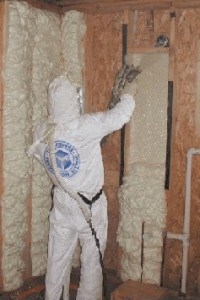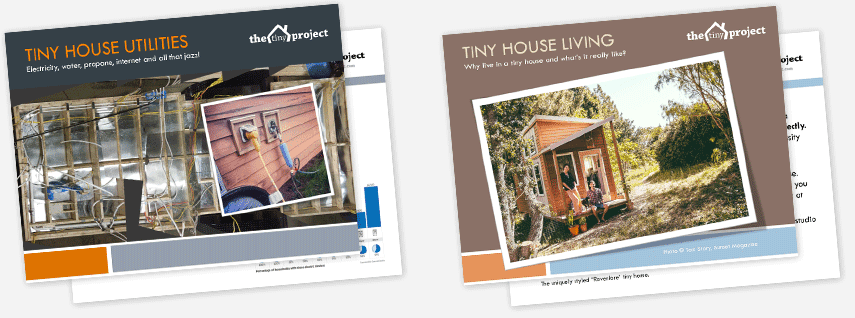Tiny House Insulation: Efficiency vs. Health
For most of my design/planning process I have been pretty sold on using closed-cell spray foam insulation. Now I'm reconsidering, and wanting go with a more natural alternative if possible.
Closed-cell Spray Foam
Closed-cell spray foam costs more than most other types of insulation (and has to be installed by a professional - so doesn't jive with a lot of tiny house builders' DIY thinking), but it has so many benefits:
- Efficiency - highest R-value per square inch of any insulation material (approx R6-8/inch - great for use in the narrow 2x4 walls most tiny home builders use to maximize space, without having to sacrifice energy efficiency.
- Air Tight - Adds to effective R-value by filling any and all gaps, to avoid any air leaks, thus creating a very air-tight envelope.
- Structural Rigidity - dries hard and adds considerable rigidity and strength to the structural walls of the house.
- Vapor Barrier - acts as a vapor barrier, so no extra membrane needed.

Spray foam installation
The downside:
- Cost! - can be thousands to install - typically 30% or so above other options.
- Hazardous Materials? - Though many forms of spray foam have some soy content, they are still predominantly petroleum-based products.
This means spray foams are in no way sustainable, recyclable, or healthy for the house inhabitants. Though most closed-cell foam producers claim there is little or no off-gassing, I'm worried about air quality and potential health effects, not to mention environmental impact in both production and eventual disposal of the product.
Just look at the bodysuit the guy in the photo has to wear to install this stuff -- that obviously is not a healthy product. Looks comparable to a uranium leak!
Alternatives
There are many well-known natural insulation materials. Cellulose is probably the most common. Though attractive for those with 6, 8, or 12 inch walls, most natural options are not nearly as efficient per inch as spray foam. But my current 2nd choice behind spray foam is: Natural Wool! Oregon Shepherd produces natural, sustainable, environmentally friendly and healthy wool insulation. Here are some of the benefits they advertise:
- Fire and vermin resistant
- Non-toxic
- Resists mold growth
- Acoustically superior
- A naturally “green”, energy saving product
- Eliminates voids and air pockets common with other insulation materials
- Reduces air infiltration and increases the “effective R-value”

Natural wool installation
Notice the guy in this photo: Plain clothes. No health issues when coming in direct contact or breathing this material!
All these things sound vary attractive to me, but I can't avoid the importance of a very well insulated house. I know of a few tiny house builders using this natural wool insulation who are located in the Northwest. The climate there is more mild than most of the rest of the country, so I'm wondering how well this wool will work in colder climates, if I end up somewhere with less pleasant winters.
I'm waiting to hear back from Oregon Shepherd about R-value/inch specifics in order to make my final decision. If I can devise a way to use healthy, sustainable products to achieve a similar overall insulation efficiency, then I'm certainly going to go all natural!
What do you use for insulation?
I know many people who have used and have loved spray foam. Anyone using something more natural?



I didn't like the idea of paying for a chemical spray foam either. I actually realized though that you could achieve a similar effect by cutting the 4'x8' sheeting foam panels right out of Lowes/Homedepot to fit into the wall spaces, and then spraying some of that off-the-counter foam-in-a-can around the edges of each piece to fill 100% of the air space between the 2x4's.
I'm sure you would need lots of cans of foam though, but at least the foam panels seem like they would be safer.
Thanks, David. I just figured if I am using a petroleum-based foam of any kind (spray or board) I might as well go all out and get the best possible. Spray foam is also so much less work (no cutting to fit), and it's done in a day. But you do pay for it...
I am a highschool theaecr in Canada and we are looking to build a small building using alternative building material. I was at a workshop today and met an architect from Dalhousie University who suggested we use phone books. He has built using phone books and said they are not only load bearing but can even be made into roof trusses.
Tell me more about your "shading" devices and deck please. Also what siding. Material will be used. Thanks
I plan to build the roof extensions so they can fold up/down for travel, but when opened will provide shade from he summer sun. I'm not quite sure what these will be made out of yet. Possibly 2x4s and the same metal roofing, but possibly something thinner and lighter. Deck will be a similar concept. Will be hinged at the bottom and fold up for travel. It will also help protect the large south facing windows during travel. Then it will fold down, partially supported by cables form the side of he house, and of course with supports underneath as well to hold the weight. Siding material depends on what I can find locally. I'm trying to use reclaimed wood if possible. But might have to just get new cedar lap siding, maybe even pre-stained to save some time.
For what it's worth, my husband and I finished an attic loft space in our small, old, bungalow for ours boys to live in. We opted for the spray foam insulation, bought pricey kits online, everything worked well and then, they made my boys deathly ill. ALL of them got horrific upper respiratory/lung/sinus issues that required multiple doctor visits and medications. Then I set out reading MSDS sheets, safety data, etc. and of course it's a hazard. We tend to be all natural and avoid the doctor, so the fact that they went to the Dr. AND got prescription drugs should tell you how bad the illness was. I felt horrible, like we truly had caused irreversible lung damage to our children. SIGH -- Two years have passed now, everything has "cured" I suppose and multiple layers of drywall, mud, paint, etc. have sealed it enough to where we no longer have issues. BUT -- we will NEVER EVER EVER again in our lives use "green" spray foam insulation. We figure your environment doesn't matter much if you are dead and can't enjoy it! 🙂
Thank you so much for sharing. I guess if I do decide to use spray foam, I will have to look at the data sheets carefully and make sure I know what I am getting. So sorry to hear about your boy's illness caused by this. Can you tell me exactly what kind of foam you used?
My tiny house is not on a trailer, it is a converted 8X12 tool shed my step father built 25 years ago. It was built with rough cut 2x6's, so I had plenty of room for insulation. I went with foam board and foam in a can in the floor and ceiling because I could get second hand pretty cheaply and could do it myself. I needed to get started quick before winter settled in! Then a month later one of my neighbors had built a new house and was having a company come spray in blown in cellulose. As I'd been looking at that as an option anyway, I had them spray my house at the same time at a greatly reduced rate since they were already set up next door. I am very happy with the cellulose and 6.5 inches of the stuff has kept me plenty warm! If I do it again, I will likely rent the blower and use loose pack cellulose blown in myself. I did this for my grandmothers attic and it went very smoothly and was fairly easy.
Good to know. If I could afford the space the make the walls thicker, I'd definitely go with a cheaper, more green alternative. As it currently stands, spray foam is still the top chose for me.
I'm curious about the settling factor for any type of lose insulation. From my experience with this type, even in non moving structures gaps do form at the top after time. So moving a unite down the road will even compact the insulation even more.
I agree. Any loose type of insulation will settle over time and become much less effective. That's another reason why I am leaning towards spray foam. It dries rigid and will stay in place for many years.
Alex,
I enjoy so much hearing about your journey. I would love to hear from someone who has used the wool insulation and the cost. Any idea if that is available down here near northern Mississippi?
I've only heard about people using it in the Northwest. If you contact Portland Alternative Dwellings (https://padtinyhouses.com/), I believe several of their houses use wool, or at least they will know of some that do.
What kind of toilet did you use? Also what did you use for holding tanks for water and waste?
Hi Craig - Both your questions are answered on our FAQ page: https://tiny-project.com/frequently-asked-questions/ Take a look!
It's ironic that so much weight is given to the environmental impact of spray foam without taking a deeper look at the ethical implications of using wool. If you look at the greenhouse gas emissions from livestock, they account for a massive amount of global warming (estimates ranging from 16% to 51%, with the consensus being that it is more than all global transportation combined). Sheep are the worst emitter of all, even worse than cattle. There's no perfect world but the idea of presenting wool as some sort of more sustainable option simply is not true.
You should also consider the way in which these animals at treated. If you don't believe it's bad, watch this (warning, it's graphic, but if you can't handle seeing that, should you really be supporting it with your money?): https://www.youtube.com/watch?v=siTvjWE2aVw.